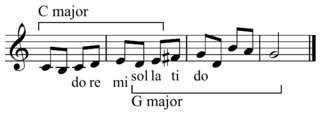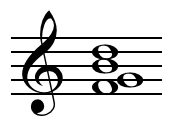
The major scale is one of the most commonly used musical scales, especially in Western music. It is one of the diatonic scales. Like many musical scales, it is made up of seven notes: the eighth duplicates the first at double its frequency so that it is called a higher octave of the same note.
An octatonic scale is any eight-note musical scale. However, the term most often refers to the ancohemitonic symmetric scale composed of alternating whole and half steps, as shown at right. In classical theory, this symmetrical scale is commonly called the octatonic scale, although there are a total of 43 enharmonically non-equivalent, transpositionally non-equivalent eight-note sets.
A jazz scale is any musical scale used in jazz. Many "jazz scales" are common scales drawn from Western European classical music, including the diatonic, whole-tone, octatonic, and the modes of the ascending melodic minor. All of these scales were commonly used by late nineteenth and early twentieth-century composers such as Rimsky-Korsakov, Debussy, Ravel and Stravinsky, often in ways that directly anticipate jazz practice. Some jazz scales, such as the bebop scales, add additional chromatic passing tones to the familiar diatonic scales.

A chord, in music, is any harmonic set of pitches consisting of multiple notes that are sounded simultaneously, or nearly so. For many practical and theoretical purposes, arpeggios and other types of broken chords may also be considered as chords in the right musical context.

In music, modulation is the change from one tonality to another. This may or may not be accompanied by a change in key signature. Modulations articulate or create the structure or form of many pieces, as well as add interest. Treatment of a chord as the tonic for less than a phrase is considered tonicization.
Modulation is the essential part of the art. Without it there is little music, for a piece derives its true beauty not from the large number of fixed modes which it embraces but rather from the subtle fabric of its modulation.
In music theory, an augmented sixth chord contains the interval of an augmented sixth, usually above its bass tone. This chord has its origins in the Renaissance, was further developed in the Baroque, and became a distinctive part of the musical style of the Classical and Romantic periods.
In jazz, the term upper structure or "upper structure triad" refers to a voicing approach developed by jazz pianists and arrangers defined by the sounding of a major or minor triad in the uppermost pitches of a more complex harmony.
In Classical music theory, a Neapolitan chord is a major chord built on the lowered (flatted) second (supertonic) scale degree. In Schenkerian analysis, it is known as a Phrygian II, since in minor scales the chord is built on the notes of the corresponding Phrygian mode.
The diminished seventh chord is a four-note chord composed of a root note, together with a minor third, a diminished fifth, and a diminished seventh above the root:. For example, the diminished seventh chord built on B, commonly written as Bo7, has pitches B-D-F-A♭:
In music and music theory, a hexatonic scale is a scale with six pitches or notes per octave. Famous examples include the whole-tone scale, C D E F♯ G♯ A♯ C; the augmented scale, C D♯ E G A♭ B C; the Prometheus scale, C D E F♯ A B♭ C; and the blues scale, C E♭ F G♭ G B♭ C. A hexatonic scale can also be formed by stacking perfect fifths. This results in a diatonic scale with one note removed.

In music theory, the harmonic major scale is a musical scale found in some music from the common practice era and now used occasionally, most often in jazz. In George Russell's Lydian Chromatic Concept it is the fifth mode (V) of the Lydian Diminished scale. It corresponds to the Raga Sarasangi in Indian Carnatic music.
The harmonic minor scale is a musical scale derived from the natural minor scale, with the minor seventh degree raised by one semitone to a major seventh, creating an augmented second between the sixth and seventh degrees.
In music theory, the half-diminished seventh chord is a seventh chord composed of a root note, together with a minor third, a diminished fifth, and a minor seventh. For example, the half-diminished seventh chord built on B, commonly written as Bm7(♭5), or Bø7, has pitches B-D-F-A:
In music, the major Locrian scale, also called the Locrian major scale, is the scale obtained by sharpening the second and third notes of the diatonic Locrian mode. With a tonic of C, it consists of the notes C D E F G♭ A♭ B♭. It can be described as a whole tone scale extending from G♭ to E, with F introduced within the diminished third interval from E to G♭. The scale therefore shares with the Locrian mode the property of having a diminished fifth above the tonic.

Diatonic and chromatic are terms in music theory that are most often used to characterize scales, and are also applied to musical instruments, intervals, chords, notes, musical styles, and kinds of harmony. They are very often used as a pair, especially when applied to contrasting features of the common practice music of the period 1600–1900.
In music theory, the dominant seventh flat five chord is a seventh chord composed of a root note, together with a major third, a diminished fifth, and a minor seventh above the root. For example, the dominant seventh flat five chord built on C, commonly written as C7♭5, is composed of the pitches C–E–G♭–B♭:

In music, the seventh factor of a chord is the note or pitch seven scale degrees above the root or tonal center. When the seventh is the bass note, or lowest note, of the expressed chord, the chord is in third inversion.
The jazz minor scale or ascending melodic minor scale is a derivative of the melodic minor scale, except only the ascending form of the scale is used. As the name implies, it is primarily used in jazz. It may be derived from the major scale with a minor third, making it a synthetic scale, and features a dominant seventh chord on the fifth degree (V) like the harmonic minor scale. It can also be derived from the diatonic Dorian mode with a major seventh.
The Hungarian major scale is a heptatonic scale subset of the octatonic scale with an omitted ♭2 degree. It has the following interval structure in semitones: 3, 1, 2, 1, 2, 1, 2, giving it the notes C D♯ E F♯ G A B♭ in the key of C. It is, "used extensively in Hungarian gypsy music [sic]", as well as in classical music by composers including Franz Liszt and Zoltán Kodály ," as well as in Thea Musgrave's Horn Concerto (1971). As a chord scale, Hungarian Major is both a dominant and a diminished scale, with a fully diminished seventh chord composed of C, D#, F#, and A, and a dominant seventh chord composed of C, E, G, and Bb. This is an enharmonic mode of Bb Harmonic Major, along with G Harmonic Minor and E Hungarian Minor. The root note of D Aeolian Dominant is raised a semitone to D#, and the root note of B Phrygian Dominant lowered a semitone to Bb. There is also a ♮6 & ♮2 with the Bb Super Lydian Augmented scale, lowering the C# & G# to C♮ & G♮.
The Romanian major scale is a heptatonic scale subset of the octatonic scale with an omitted ♭3 degree. It is noted for its flattened 2nd and sharpened fourth degrees, the latter a distinctive feature of Romanian traditional music. It has the following interval structure in semitones: 1, 3, 2, 1, 2, 1, 2, giving it the notes C, D♭, E, F♯, G, A, B♭ in the key of C. Though it is called a major scale, it is typically played over a C13 dominant chord. This is an enharmonic mode of B Harmonic Minor, along with D Harmonic Major. The root note of F Harmonic Major is raised a semitone to F#, and the root note of D Aeolian Dominant lowered a semitone to Db. There is also a ♮6 with the Db Super Lydian Augmented scale, lowering the B♮ to Bb.





